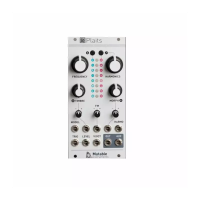: Balance between oscillator 1 and 2.
: Sub oscillator/transient generator level.
: Sub oscillator/transient generator waveform (see below).
: Cross-modulation method used to combine the sound of oscillators 1 and 2.
: Cross-modulation amount.
: Amount of overdrive/fuzz applied to the signal.
: Amount of sample rate reduction (sometimes known as bitcrushing) applied to the
Here is a list of sub-oscillator/transient generator waveforms. The first 6 settings correspond to the
sub-oscillator, which is an oscillator of its own, playing always one or two octave lower than the
oscillator 1. The next settings disable the sub-oscillator and enable various flavors of transient
generators, which will produce a short, clicky sound at the beginning of the note:
square sub-oscillator, 1 octave below osc. 1
triangle sub-oscillator, 1 octave below osc. 1
25% pulse sub-oscillator, 1 octave below osc. 1
square sub-oscillator, 2 octaves below osc. 1
triangle sub-oscillator, 2 octaves below osc. 1
25% pulse sub-oscillator, 2 octaves below osc. 1
produces a discrete click which can emphasizes the percussiveness of a note.
produces a sound similar to that of a skipping CD.
is a burst of noise with a slow attack.
adds a metallic sounding, high-pitched click.
adds a low-pitched discontinuity, useful for spicing up a kick drum.
parameter controls how oscillator 1 and oscillator 2 are blended together. The
different modulation modes are:
Ambika – User manual | Mutable Instruments http://mutable-instruments.net/ambika/manual
19 of 44 2/17/17 4:58 PM

